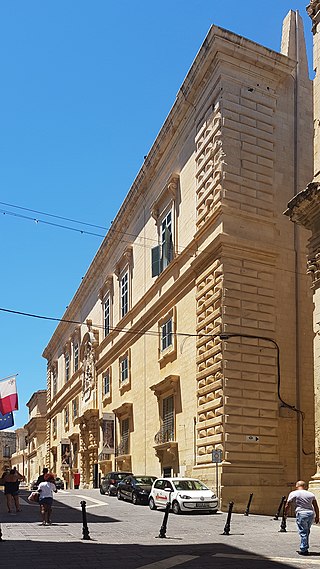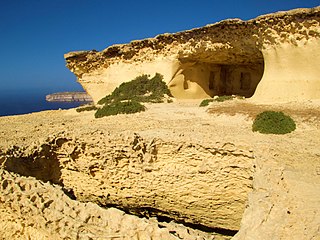
San Anton Palace is a palace in Attard, Malta, that currently serves as the official residence of the president of Malta. It was originally built in the early 17th century as a country villa for Antoine de Paule, a knight of the Order of St. John. It was expanded into a palace following de Paule's election as Grand Master in 1623.

The Basilica of the National Shrine of the Blessed Virgin of Ta' Pinu is a Roman Catholic minor basilica and national shrine located some 700 metres (2,300 ft) from the village of Għarb on the island of Gozo, the sister island of Malta.

The Sacred Heart of Jesus Church is in Fontana, Gozo Island, part of the Maltese Archipelago. It is the parish church of Fontana, one of the smallest villages on the island.

Heritage Malta is the Maltese national agency for museums, conservation practice and cultural heritage. Created by the Cultural Heritage Act, enacted in 2002, the national agency replaced the former Museums Department.

The Citadel, also known as the Castello, is the citadel of Victoria on the island of Gozo, Malta. The area has been inhabited since the Bronze Age, and the site now occupied by the Cittadella is believed to have been the acropolis of the Punic-Roman city of Gaulos or Glauconis Civitas.

St. George's Basilica or the Basilica and Collegiate Parish Church of Saint George, also simply known as San Ġorġ in Maltese, is a historic Baroque church situated in the middle of Gozo, the second largest island in the Maltese archipelago, and is surrounded by a maze of old narrow streets and alleys. The church had been rebuilt numerous times during the Middle Ages. Today's basilica was built between 1672 and 1678.

Royal Naval Hospital Bighi also known as Bighi Hospital, was a major naval hospital located in the small town of Kalkara on the island of Malta. It was built on the site of the gardens of Palazzo Bichi, that was periodically known as Palazzo Salvatore. RNH Bighi served the eastern Mediterranean in the 19th and 20th centuries and, in conjunction with the RN Hospital at Mtarfa, contributed to the nursing and medical care of casualties whenever hostilities occurred in the Mediterranean. The building is now known as Villa Bighi and it houses a restoration unit.

The Metropolitan Cathedral of Saint Paul, commonly known as St Paul's Cathedral or the Mdina Cathedral, is a Catholic cathedral in Mdina, Malta, dedicated to St. Paul the Apostle. The cathedral was founded in the 12th century, and according to tradition it stands on the site of where Roman governor Publius met St. Paul following his shipwreck on Malta. The original cathedral was severely damaged in the 1693 Sicily earthquake, so it was dismantled and rebuilt in the Baroque style to a design of the Maltese architect Lorenzo Gafà between 1696 and 1705. The cathedral is regarded as Gafà's masterpiece.

The Gozo Museum of Archaeology is a museum in the Cittadella, the oldest part of the city, of Victoria in Gozo, Malta. The museum of Archaeology was opened in 1960 as the first public museum in Gozo and was known as the Gozo Museum. The museum was redesigned and reopened in 1986 as the Archaeology Museum of Gozo. Today it is known as the Gozo Museum of Archaeology or the National Museum of Archaeology. The museum features archaeological artifacts and relics and displays covering the cultural history of the Island of Gozo from the prehistoric era to the early modern period. Its exhibits include the Maymūnah Stone.

Ta' Kola Windmill, Maltese: Il-Mitħna ta' Kola, is a windmill in the village of Xagħra, on the island of Gozo in the Maltese archipelago. It was built in 1725 by the Fondazione Vilhena of Grand Master Manoel de Vilhena, and was rebuilt in the 1780s. It became a museum in 1992.

Fort Chambray or Fort Chambrai is a bastioned fort located in the precincts of Għajnsielem, on the island of Gozo, Malta. It was built in the mid-18th century by the Order of Saint John, in an area known as Ras it-Tafal, between the port of Mġarr and Xatt l-Aħmar. The fort was meant to be the citadel of a new city which was to replace the Cittadella as the island's capital, but this plan never materialized.

The Auberge d'Italie is an auberge in Valletta, Malta. It was built at various stages in the late 16th century to house knights of the Order of Saint John from the langue of Italy, and it originally had a Mannerist design by Girolamo Cassar and several other architects. The building continued to be modified throughout the course of the 17th century, with the last major renovation being carried out in the 1680s during the magistracy of Gregorio Carafa, giving the building a Baroque character.

The Church of Saint John the Baptist, commonly known as the Rotunda of Xewkija or Xewkija Rotunda, is a Roman Catholic church in Xewkija, Gozo, Malta.

Villa Francia, initially named as Palazzo Francia, then named as Villa Preziosi, and officially known as Palazzo Francia and Francia Estate, is an 18th-century palace in Lija, Malta. The palace was built circa 1757, by Francesco Preziosi, with baroque architecture that gave a sense of pride and power to noble people at the time. The first ambitious owner became bankrupt with the expenses of the palace, to make it an outstanding building and incomparable with others, and because of this he was pressured to sell his possession by the Order of St. John to pay his accumulated debts.

The National Inventory of the Cultural Property of the Maltese Islands (NICPMI) is a heritage register listing the cultural property of Malta. The inventory includes properties such as archaeological sites, fortifications, religious buildings, monuments and other buildings. The NICPMI is under the responsibility of the Superintendence for Cultural Heritage (SCH), which was founded in 2002 to replace the Antiquities Act. The NICPMI was established on 16 December 2011.

Palazzo Parisio, formerly known as Scicluna Palace, Palazzo Scicluna, and officially Palazzo Parisio and Gardens, is a 20th-century palace in Naxxar, Malta. On site was a hunting lodge built in 1733 by Paolo Parisio, and was used as a summer or permanent residence, barracks and a college, before being acquired by the Marquis Scicluna in 1898.

The Gozo Aqueduct is an aqueduct on the island of Gozo, Malta. It was built by the British between 1839 and 1843 to transport water from Għar Ilma in the limits of Kerċem to Victoria. A reservoir was built within the ditch of the Cittadella to store water which most probably stored water coming from the Cittadella itself. An obelisk was built near the reservoirs to commemorate the opening of the aqueduct.

The Cathedral of the Assumption of the Blessed Virgin Mary into Heaven is a Roman Catholic cathedral in the Cittadella of Victoria in Gozo, Malta. The cathedral is dedicated to the Assumption of Mary, and has been the seat of the Roman Catholic Diocese of Gozo since the formation of the diocese in 1864.

Palazzo Santa Sofia is a palace in Mdina, Malta, located in Villegaignon Street, across the square from the cathedral. Its ground floor was built in 1233, and it is believed to be the oldest surviving building in the city. The upper floor is of a much later construction, being built in the 20th century.

Ras il-Wardija is a promontory in the limits of San Lawrenz, on the southwest coast of Gozo, Malta. It contains the remains of a Punic-Roman sanctuary, which was excavated by Italian archaeologists in the 1960s. The area is privately owned and it is currently in a dilapidated state.





















